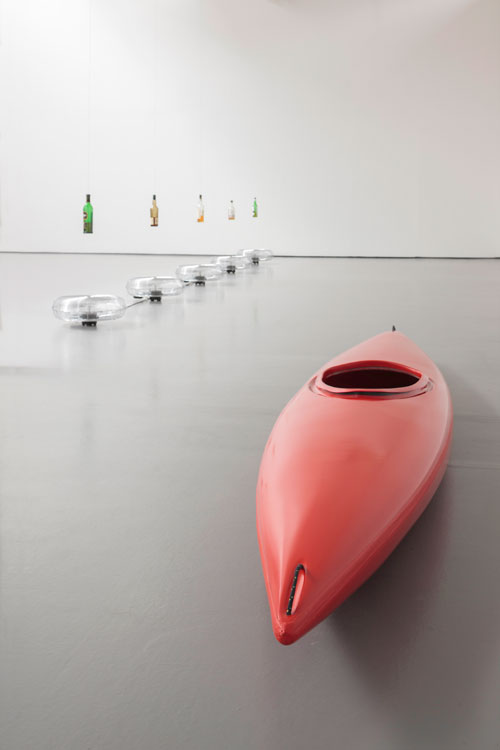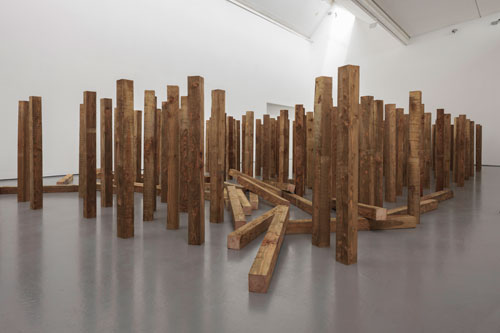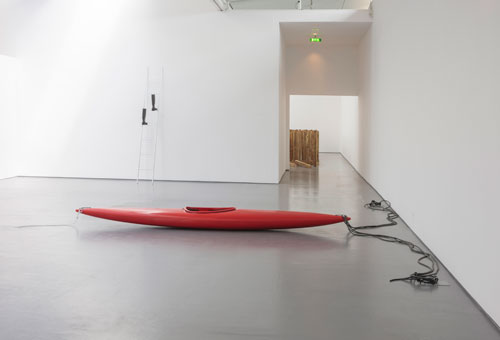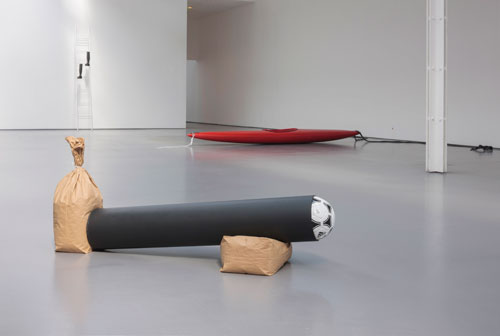

Dundee Contemporary Arts, Scotland
4 July – 20 September 2015
by DARRAN ANDERSON
To be is to be observed, Bishop Berkeley claimed. Whether a tree falling unseen in the forest makes a sound or not is incidental. It leaves traces, wreckage, reverberations. Birds scatter into the canopy and beyond. Butterflies turn eventually into tornadoes. The artwork of Roman Signer (b1938, Switzerland) is made up ostensibly of the remnants of past events. He is an artist of echoes, a witness to the unheard falling tree.
At times, this appears literal. In Signer’s Installation with wooden beams (2015), the gallery space is transformed in a simple but resonant way. The artist has placed a grid of upright timber beams through the room and then knocked one over to create a partial domino effect. The result, which the viewer walks around, and occasionally steps over, is like an accidental path through a forest. It is the repercussion of an action and the incorporation of the laws of both chance and cause and effect into art (or rather it highlights the fact that they are always there). To a cynic, it is just a load of wooden posts in an empty room, but it’s hard not to feel something strangely evocative here. It underlines the suggestive power of art; a painting, after all, is just pigment smeared on canvas. The stillness of the gallery space combined with ambient sounds from outside take the mind to other places; a hint of impossible unseen forests in a corner of the city.
The sense of Signer being an artist of aftermaths continues with Kayak with rubber (2015). The artist attached the boat to two rubber bands, which he then stretched across the breadth of the gallery. With the vessel tautly levitating in the middle, he placed a lit candle beneath one of the ropes. When it burned through, the rope snapped and the built-up pressure propelled the kayak across the room, striking the gallery wall with enough force to leave a considerable dent. The resulting piece is a playful questioning of what art is, in a tradition somewhere between Fluxus and Marcel Duchamp. Is it the event? The objects left behind? The fresh scar on an otherwise immaculate wall? The memory of an event we did not witness? Perhaps the art is in our wondering, or the artist’s audacity.
The visual has always maintained a primacy in art that it has in the wider world. The first sensation approaching Whisky boat (2015), however, is the unmistakable aroma of Scotch. In a turnaround vaguely reminiscent of René Magritte, Signer has filled a kayak (a recurring component of his iconography) with more than 200 litres of whisky. The urge, if not to drink, is to touch, to dip your hand in. Again, it is absurd, but it has a peculiar power of reframing, drawing attention to study the otherwise mundane; the barely trembling meniscus and reflections of a pool of alcohol.
For Bar (2007), Signer has hung five whisky bottles above fans pointed at the ceiling. The result is a strange dance of orbits, with the disembodied bottles moving almost as if in invisible revelry. There is a childlike glee to such artifice but perhaps a deeper symbolism at work. For all the local cultural touchstones of whisky, it’s possible to detect a distinct sense of waste in these works; the incessant orbits of the bottles, the possibility of drowning inside a boat in an arid room. They are all marked by missing protagonists. Events might well be logged and recorded, but time makes ghosts of all participants.
Ladder (1995) mixes the same sense of Fluxus-esque vandal jest with a sense of deliberately absurdist phantom absence. We fill in the gaps, pattern-seeking mammals that we are, and inevitably imagine a figure occupying the empty boots and continuing to climb the rungs. What this signifies is less clear but perhaps that is enough. We are drawn back to wonder about our wonderings.
Signer has a lightness of touch and mischief that almost tips into menace. With Football, cannon with tent (2014), we uncover a potential ambush. It would be easy for the artist to have made it more obviously perilous, suspending a swinging razor-sharp pendulum perhaps. Plaudits come much more easily and abundantly to tragedies than comedies. Yet, as with the best comedies, there is an underlying atmosphere of tension and desperation. This is a work that seems like the beginning of a dark turn of events, leaving the identities of the antagonists and a reciprocal downward spiral to the viewer’s imagination. In deceptively simple terms, it is just a cannon primed to launch a ball at high speed and force into the unsuspecting occupants of a tent. It is worth remembering that Duchamp (particularly In Advance of the Broken Arm), Sameul Beckett and Harold Pinter all emerged from a slapstick tradition and retained a great deal of it. There is palpable menace beneath the pratfalls and an element of farce in most horror.
In a side room, Vers la flamme (2014) is being screened. Signer has placed Icelandic pianist Víkingur Ólafsson floating in Lake Vernago in the Italian Alps. He is playing a sonata from 1914 by the Russian composer Alexander Scriabin called Vers la flamme (Towards the flame), a piece inspired by the composer’s heartfelt belief that the Earth was heating up towards annihilation. Dismissed at the time as an eccentric if exceptionally gifted crank, global warming and the rise in sea level have retrospectively recast Scriabin as an unlikely prophet. This reassessment and the film itself are highly symbolic of Signer’s work as a whole. His art is lighthearted and weighty. It is always thought-provoking and atmospheric while appearing almost throwaway. These are poetic barbed jokes hinting at deeper darker cosmic ones (at whose expense is a question worth asking). Littering his work with empty space, Signer trusts the audience enough to let them fill in the gaps, while acknowledging that there are some spaces too fathomless to fill with anything but distant echoes. Yet they resound, and resound memorably, nonetheless.



